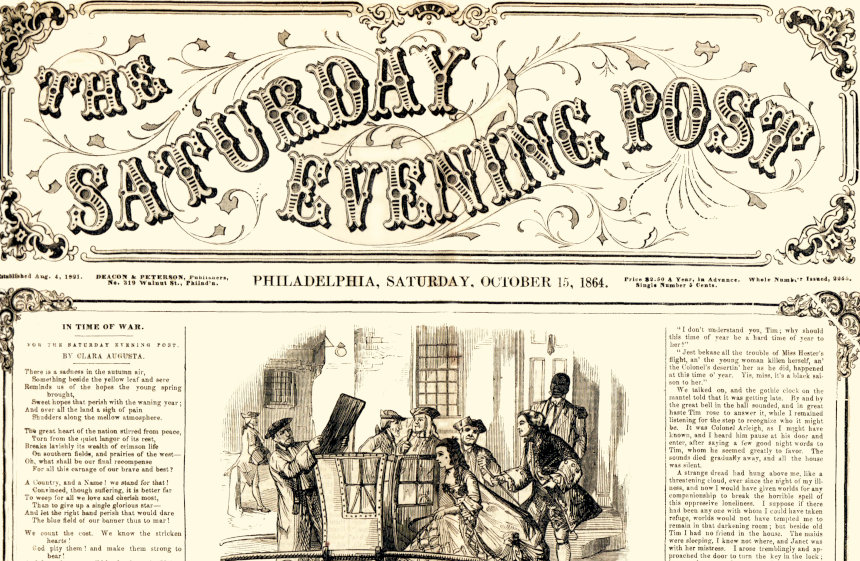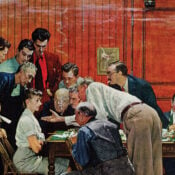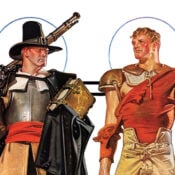 The Saturday Evening Post was launched out of the same Philadelphia print shop where Ben Franklin had once published his Pennsylvania Gazette. It all began when a colleague of shop owner Samuel Atkinson had the idea of printing a poem about a blind girl in the city who set type by hand. Once they had gathered a list of 200 subscribers to the poem, it seemed only logical to start a weekly newspaper.
The Saturday Evening Post was launched out of the same Philadelphia print shop where Ben Franklin had once published his Pennsylvania Gazette. It all began when a colleague of shop owner Samuel Atkinson had the idea of printing a poem about a blind girl in the city who set type by hand. Once they had gathered a list of 200 subscribers to the poem, it seemed only logical to start a weekly newspaper.
The new publication was called The Saturday Evening Post because it would be printed in time to be delivered to Philadelphia addresses in the second mail delivery on Saturdays. (The U.S. mail was delivered twice daily until 1950.)
The Post’s first issue appeared on August 4, 1821. In its original incarnation, it was clearly more newspaper than magazine. But even then, much of the content had a magazine-like feel. The tone was open-minded but skeptical, moral but with a sense of humor. It covered a bit of everything about America: business, law, exploration, fashion, etiquette, agriculture, and science.
Throughout the 1800s, this broadsheet also chronicled the changing fortunes of the country: the building of the transcontinental railroad, the gold rush, and the settling of the western territories. It also brought reports of the Mexican-American War in 1854, the Civil War in 1861, and the American Indian Wars of the 1880s.
Circulation surged to 90,000 before the Civil War, and the publication gained a national reputation for the high quality of its content. In 1871, a reviewer wrote of The Saturday Evening Post, “Nearly all the prominent writers of the country, for the last 50 years, have contributed to its columns, and the reputations of many were established through its agency.”
Some of those early contributors are now literary legends, including Edgar Allan Poe, James Fenimore Cooper, Harriet Beecher Stowe, Washington Irving, and Mark Twain.
As the 1800s came to an end, a new publisher, Cyrus Curtis, would come into the picture, bringing along George Horace Lorimer as editor. Together they would reimagine the publication as a bound edition with an illustrated cover — essentially inventing the concept of the modern magazine.
In the pages that follow, we share some selections from the 1800s. And throughout the year, as we celebrate our bicentennial, we will continue to tell the extraordinary history of The Saturday Evening Post.
—Jeff Nilsson
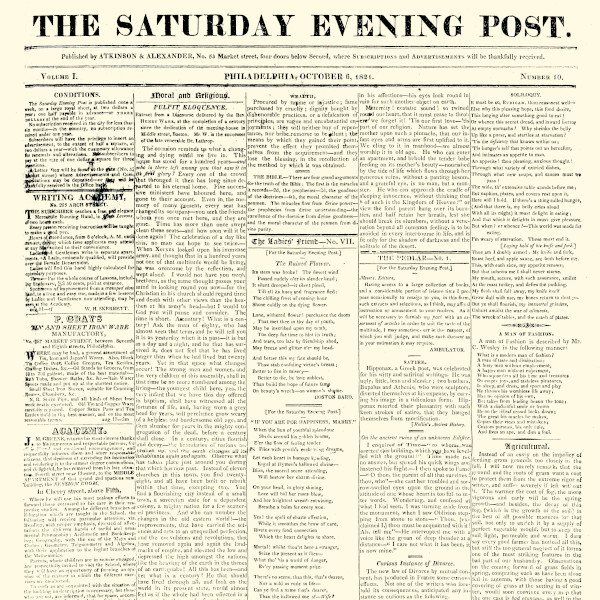
1821
Marital Advice
Homespun wisdom mixed with domestic and international news even in the earliest editions of the Post. Here, William Penn offered his guidance on choosing a wife
Do thou be wise — prefer the person before money, virtue before beauty, the mind before the body — then thou hast a wife, a friend, a companion, a second self, one that bears an equal share with thee in all thy toils and troubles.
—August 18, 1821
America Gains Florida
Maj. Gen. Andrew Jackson, then Commissioner of the United States, announced Spain ceding its possessions in Florida to the U.S.
I have thought fit to issue this my proclamation, to declare that the government heretofore exercised over the said Provinces under the authority of Spain has ceased, and that that of the United States of America is established over the same — that the inhabitants thereof will be incorporated in the union of the United States.
—August 18, 1821
1823
America Dresses Up
Americans had come a long way from the days when their Puritan forebears regarded all personal adornment and vanity as an invitation to sin
Women should not confine their attention to their public appearance. They should accustom themselves to an habitual neatness, so that in the most careless undress, in their most unguarded hours, they may have no reason to be ashamed of their appearance. They will not easily believe how much men consider their dress as expressive of their characters; vanity, levity, slovenliness, folly, appear through it. An elegant simplicity is an equal proof of taste and of delicacy.
—“Decency in Dress,” June 28, 1823
1826
John Adams’ Final Toast
Thomas Jefferson and John Adams had become enemies in the early years of the Republic, but late in life, they began corresponding again and reunited in the friendship they had known in revolutionary days. On the 50th anniversary of the Declaration of Independence, they were also united in death
A gentleman arrived from the Eastward, last evening, informs that the venerable John Adams died at his seat at Quincy, near Boston, on the fourth of July, about 5 o’clock p.m., but a few hours after the sage of Monticello! United in the grand political concerns of life, thus in death they are not divided!
In the forenoon, a guest asked him for a sentiment to be delivered at table. He said, “I will give you ‘Independence forever.’” This was delivered within an hour of his dissolution.
—July 8, 1826
Portrait of a Painfully Private Beethoven
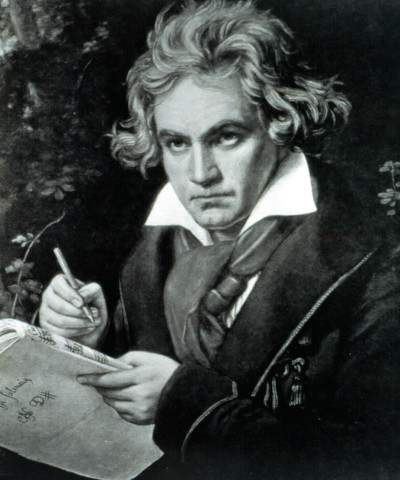
A year almost to the day before Ludwig van Beethoven died, the Post ran this item about the temperamental composer
He is very deaf, and therefore has always a small paper book with him; and what conversation takes place is carried on in writing.
I have heard him play; but to bring him so far required some management, so great was his horror of being anything like exhibited. Had he been plainly asked to do the company that favor, he would have flatly refused. He had to be cheated into it; every person left the room except Beethoven and the master of the house. These two carried on a conversation in their paper book about bank stock. The gentleman, as if by chance, struck the keys of the open piano beside which they were sitting; gradually began to run over one of Beethoven’s own compositions, made a thousand errors, and speedily blundered one passage so thoroughly that the composer condescended to stretch out his hand and put him right.
It was enough: the hand was on the piano; his companion left him on some pretext, and joined the rest of the company, who, in the next room, from which they could see and hear everything, were patiently waiting.
Beethoven, left alone, seated himself at the piano. At first he only struck now and then a few hurried and interrupted notes, as if afraid of being detected in a crime; but gradually he forgot everything else, and ran on during half an hour. The amateurs were enraptured; to the uninitiated it was more interesting to observe how the music of the man’s soul passed over his countenance.
—“Beethoven,” March 25, 1826
1838
The Coronation of Queen Victoria
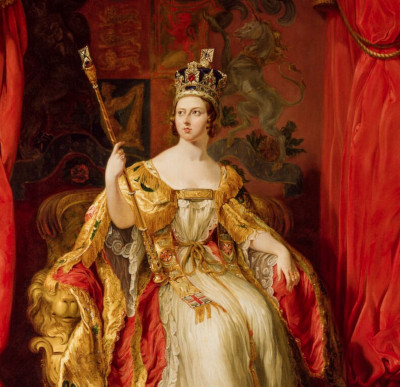
Of great interest to Americans, the event was covered in detail
From an early hour, indeed long before daylight, numbers of persons were to be seen gathering into little knots in the immediate vicinity of Buckingham Palace. …
Soon after half past nine, detachments of the Blues and the Life Guards arrived opposite the entrance gate of the palace, and their appearance was quickly followed by that of twelve of Her Majesty’s dress carriages together with the state coach. …
At a very early hour a work of perfect supererogation was performed, namely, the watering of the roads, for that was quite enough of rain to prevent the least inconvenience from dust.
In about an hour after leaving Buckingham Palace, her Majesty arrived at the west entrance of the Abbey, and was received by the great officers of state. … Archbishop of Canterbury then administered the oath. …
The Archbishop then placed the crown on her Majesty’s head, and the peers and peeresses put on their coronets, the bishops their caps, and the king-of-arms their crowns. The shouts which followed this part of the ceremony was really tumultuous.
—July 28, 1838
1857
The Dred Scott Decision
Outrage over this controversial Supreme Court case would fuel the abolitionist movement
The opinion of the Supreme Court in the Dred Scott case was delivered at Washington on March 6th, by Chief Justice Taney. [The court has] decided that negroes, whether slaves or free, that is, men of the African race, are not citizens of the United States by the Constitution.
—March 14, 1857
1859
John Brown’s Execution
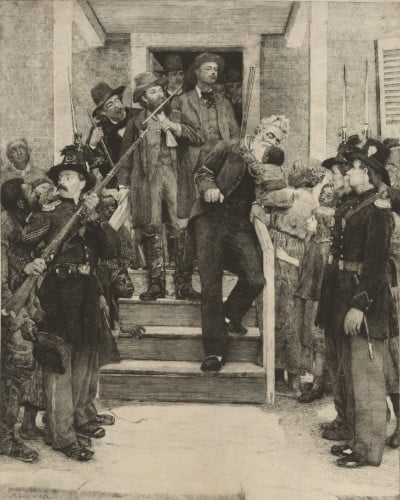
Just three years before the start of the Civil War, abolitionist John Brown was hanged for raiding an arsenal in Harper’s Ferry with the intention of arming a slave rebellion
The prisoner was brought out of jail at 11 o’clock. Before leaving he bid adieu to all his fellow prisoners. The prisoner then told the Sheriff that he was ready. His arms were then pinioned, and with a black slouch hat and the same clothes he wore during the trial, proceeded to the door, apparently calm and cheerful. As he came outside, an open wagon with a pine box was waiting for him.
On his way to the scaffold, Mr. Sadler, the undertaker who was in the wagon with him, remarked, “Captain Brown, you are a game man.”
He answered, “Yes, I was so trained up, it was one of the lessons of my mother: but it was hard to part from friends, though newly made.” Then remarking, “This is beautiful country. I never had the pleasure of seeing it before.”
The prisoner walked up the steps firmly, and was the first man on the gallows. Messrs. Avis and Campbell stood by his side, and after shaking hands and bidding an affectionate adieu, thanked them for their kindness, put the cap over his face and the rope around his neck.
Mr. Avis asked him to step forward on the trap. He replied, “You must lead me, I cannot see,” adding, “Don’t keep me waiting longer than is necessary.”
He was swung off at 15 minutes after 11 o’clock. There was a slight grasping of the hands and twitching of the muscles and then all was quiet.
—December 10, 1859
1864
March through Georgia
William Sherman’s scorched-earth campaign through Georgia was described in relatively benign terms
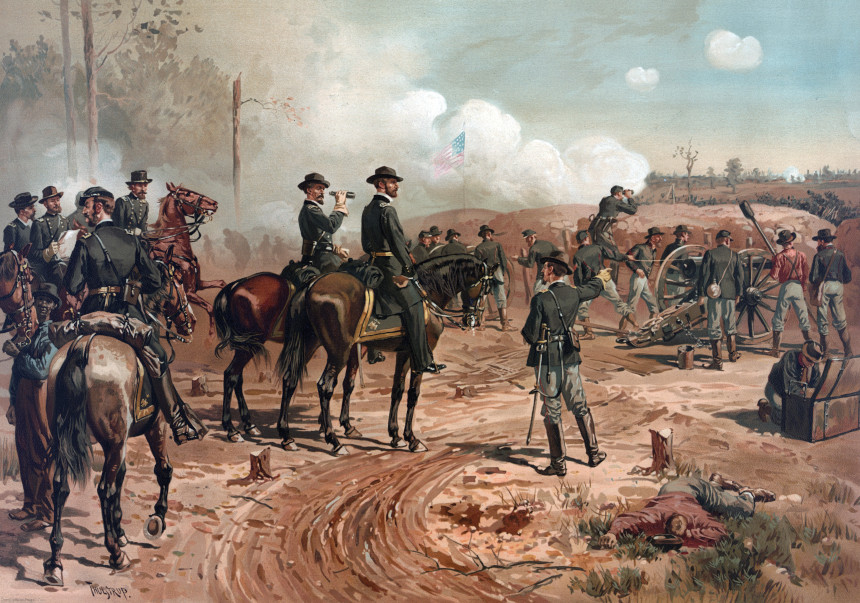
The whole loss in Sherman’s army, from wounds, sickness, captures, straggling, and all causes, is believed not to have exceeded over 1,000 in both columns. The average distance traveled per day was about 12 miles, and a halt was made for one day a week.
Gen. Sherman’s columns, in their march to the coast, sweeping over an area of territory at least 60 miles in breadth, foraged extensively on the country over which they passed, and lived in the most sumptuous manner. Not a hungry man could be found in the command. They lived on poultry almost entirely, and, as Gen. Sherman observed, “They had turkey even for breakfast, and would not look at pork; but,” he added, “I can’t speak so well of those whom I leave in the rear.”
—“Sherman’s March,” December 31, 1864
1898
Interview with John D. Rockefeller
The parsimonious industrialist shared his thoughts on money
Who is the poorest man in the world today? The poorest man I know is the man who has nothing else in the world but money. I believe it is a religious duty to get all the money you can, get it fairly, religiously and honestly — and give away all you can.
I lived within my income in my early days. I paid my washerwoman and the lady with whom I boarded and I saved a little and put it away. I paid in the Sunday school every Sunday one cent. It was all I had to give. …
Let me give you a word of advice: “Always live within your means.” What is success? Is it to get money? Well, is that success? If I had my choice today, I’d be a man with little or nothing but a purpose in life. It’s not the money in itself that is so miserable. Money is good if you know how to use it. Let me give a little word of counsel: know what you receive and how you spend it.
—“God Gave Me Money” by John D. Rockefeller, February 5, 1898
Stampede!
Buffalo Bill Cody fed America’s insatiable appetite for tales of the Wild West
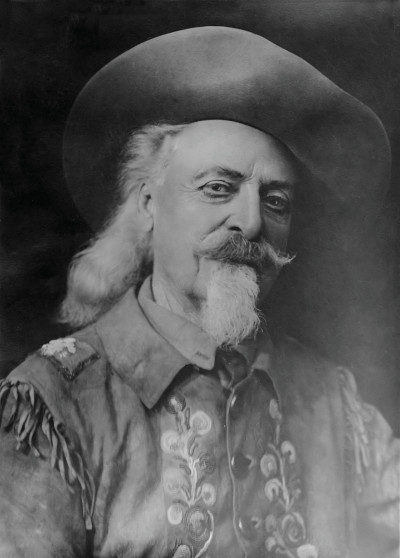
One of the most exciting scenes in connection with hunting the buffalo was a buffalo stampede. I recall an exciting incident of this kind in which the startled herd rushed through our wagon train pell-mell, frightening both men and oxen. Some of the wagons turned clear around, and many of the terrified oxen attempted to run to the hills with the heavy wagons attached to them. Others turned around so short that they tore the wagon tongues off. One big buffalo bull became entangled in one of the heavy wagon-chains. In his desperate efforts to free himself, he not only snapped the strong chain in two, but also broke the ox-yoke to which it was attached, and the last seen of him he was running toward the hills with the yoke hanging from his horns.
—“When Buffaloes Roamed in Herds” by Buffalo Bill Cody, April 23, 1898
This article is featured in the January/February 2021 issue of The Saturday Evening Post. Subscribe to the magazine for more art, inspiring stories, fiction, humor, and features from our archives.
Become a Saturday Evening Post member and enjoy unlimited access. Subscribe now
